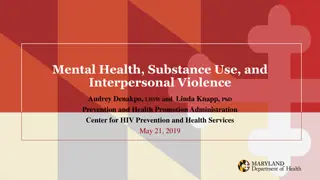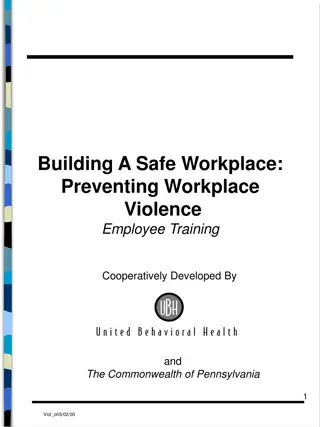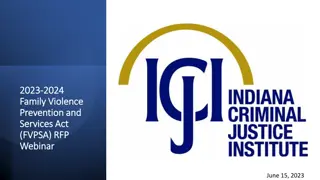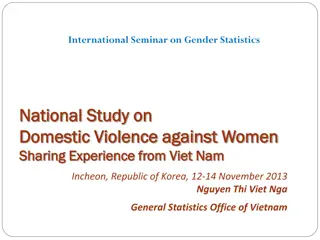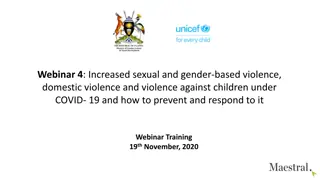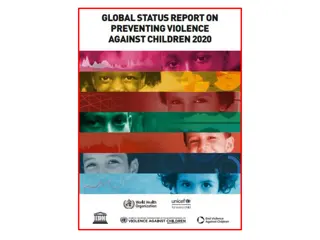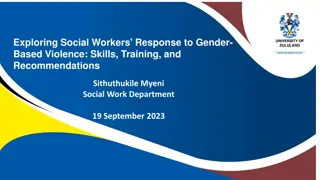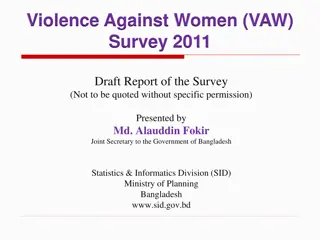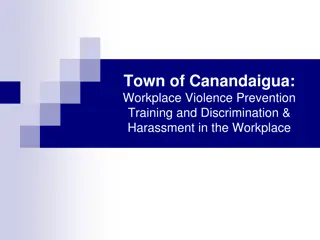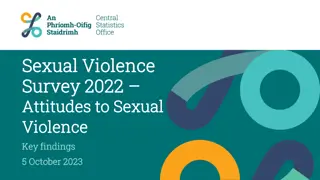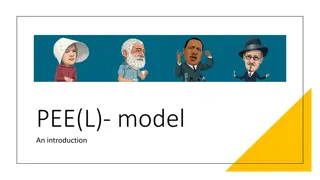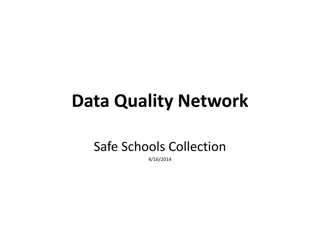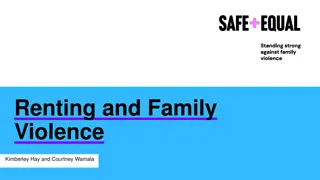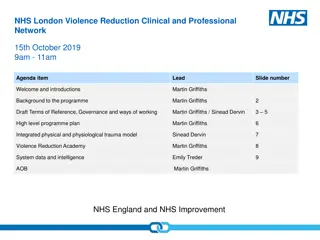Analysis of Data Collection Practices for Interpersonal Violence Services in Peel
The Peel Institute on Violence Prevention conducted a pilot study in May 2015 to identify gaps in data collection practices of health, justice, and social service agencies serving survivors of interpersonal violence in the Peel region. The study aimed to understand service availability, standardize data collection methods, and promote evidence-informed practice. Through a regional scan, survey questionnaires, and interviews, the study assessed current practices, deficiencies, barriers, and required improvements in data collection. The findings will contribute to enhancing services for survivors of interpersonal violence in Peel.
Download Presentation

Please find below an Image/Link to download the presentation.
The content on the website is provided AS IS for your information and personal use only. It may not be sold, licensed, or shared on other websites without obtaining consent from the author. Download presentation by click this link. If you encounter any issues during the download, it is possible that the publisher has removed the file from their server.
E N D
Presentation Transcript
Identifying Gaps in Data Collection Practices of Health, Justice and Social Service Agencies Serving Survivors of Interpersonal Violence in Peel. Peel Institute on Violence Prevention A Pilot Study Preliminary Analysis May 2015 Peel Institute on Violence Prevention
Overview 1. Background 2. Objectives 3. Pilot Study Overview Methodology Regional scan results 4. Study Results Response rate Reference data Quantitative analysis results Qualitative analysis results 5. Discussion Peel Institute on Violence Prevention
Background Peel Institute on Violence Prevention is conducting a multi-phase study to generate empirical evidence on some of the priority issues pertaining to interpersonal violence services in the Region of Peel. The Institute s goal is to promote evidence-informed practice and to address issues such as service navigation, connectivity and effectiveness. Peel Institute on Violence Prevention
Objectives 1. Understand the scope of services available for survivors of interpersonal violence in the Region of Peel Survey data collection practices of a cohort of agencies providing services for survivors of interpersonal violence in the Region of Peel Establish standardized method of data collection for agencies providing services for survivors of interpersonal violence in the Region of Peel Conduct research on best-practices to support community- based agencies Establish standardized mechanisms to evaluate services for survivors of interpersonal violence in the Region of Peel To promote community engagement and service-level transformation through inter-agency dialogue and collaboration 2. Peel Institute on Violence 3. Prevention 4. 5. 6.
Pilot Study Overview 1. What is the state of current data collection practices of Peel agencies serving Survivors of Interpersonal Violence (SOIV)? Peel Institute on Violence Prevention 2. What are the perceived deficiencies, barriers and required improvements in the current data collection practices according to Peel agencies serving SOIV?
Methodology Regional Scan Survey Questionnaire Interviews Peel Institute on Violence Prevention
Regional Scan Results 69 organizations identified 25 organizations provide direct services to SOIV Peel Institute on Violence Prevention Full Partial Questionnaire & Interview Questionnaire (12 agencies) (13 agencies) Target:
Results: Current State Full Questionnaire : 12/12 Agencies Completed Interview : 11/12 Agencies Completed Peel Institute on Violence Prevention Brief Questionnaire : 10/13 Agencies Completed
Results: Survey Reference Data Data Items Collected By Service Providers 1. Data about Service users: 52 Variables 2010 Census Canada demographic data variables Data Type Demographic Data Health Data Violence/Abuse Details & History Services Used # of Variables 26 4 4 18 Peel Institute on Violence Prevention 2. 2014 Statistics Canada, Victim services survey, types of services offered directly by victim service agencies Data Type Services Provided Data about Services offered: 44 Variables # of Variables 44
Results: Reference Data Data About Service Users: Demographic Data Distribution of Social Determinants Covered by Census Canada 4% 4% 4%4% 9% 0%4% 13% 4% Peel Institute on Violence Prevention 4% 4% 46% 0% Education Race Ability/Disability Geographic Origin Sexual Orientation Ethnic Background Age Social Class Language(s)/Dialects Gender Socioeconomic Status Religious Background Current Location
Peel Institute on Violence Prevention Survey Findings
Results: Agency Survey Agency Reported Purposes of Data Collection # of organizations (n=12) 11 9 5 3 Purpose of data collection Internal purposes Funder requirement Individual case charts Other1 Peel Institute on Violence Prevention 1 Other purposes include: Case management, Assists with identifying outreach needs and assists with informing requests for new funding for programs
Results: Data Items Collected By Service Providers (n=12) Data About Service Users: Demographic Data 23/26 variables covered in data collection 2/26 variables consistently collected across all agencies Date of Birth and Age Sex/Gender 19/26 variables collected by less than 50% of agencies (0%-42%) Underrepresented Demographic Variables: Social Class and Socioeconomic Status (O% - 58%) Education (33%) Geographic Origin (25%) Sexual Orientation (8%) Ethnic Background (58%) Religious background (17%) Immigration Status (33%) Peel Institute on Violence Prevention
Results: Data Items Collected By Service Providers (n=12) Data About Service Users: Health Data 100% of variables covered in data collection 0% ofvariables consistently collected across all agencies 75% of variables collected by 50% or more agencies (50%-75%) Has GP/Family Doctor 8% Peel Institute on Violence Prevention Medical History Present Health Condition 8% 8% 25% 42% 50% 17% 67% 75% Collected no response Not Collected Collected No Response Not Collected Collected No response Not Collected 8%Other 25% Mental Health Substance Use 67% Collected Not Collected No Response
Results: Data Items Collected By Service Providers (n=12) Data About Service Users: Violence/Abuse Details & History 100% of variables covered in data collection 0% ofvariables consistently collected across all agencies 100% of variables collected by more than 50% of agencies (67%-83%) Type of V/A which is the reason for current visit Peel Institute on Violence Prevention Past History of V/A Type of Previous V/A 17% 8% 9% 8% 25% 8% 75% 67% 83% Collected No Response Not Collected Collected No Response Not Collected Collected No Response Not Collected Treatment and Action(s) Taken 25% 8% 67% Collected Not Collected No Response
Results: Data Items Collected By Service Providers (n=12) Data About Service Users: Services Used 100% of variables covered in data collection 0% ofvariables consistently collected across all agencies 61% of variables collected by 50% or more agencies (50%-83%) providers for Current Reason or for Other Reasons 83% Accessing Other Healthcare Accessing Other Social Services providers for Current Reason or for Other Reasons Accessing Legal or Justice Services for Current Reason or for Other Reasons Peel Institute on Violence Prevention 25% 0% 17% 0%17% 17% 83% 58% Collected Not Collected No Response Collected Not Collected No Response Collected Not Collected No Response Are there any legal or justice services Desired but not Accessing? Are there any Social Services Desired but not Accessing? Are there any Health Services Desired but not Accessing? 17% 42% 33% 17% 50% 50% 17% 41% Collected Not Collected No Response 33% Collected Not Collected No Response Collected Not Collected No Response
Results: Data Items Collected By Service Providers (n=22) Data About Services Offered: 9% of agencies provide 98% of services explored 50% of agencies provide less than 50% of services explored 34% of services are commonly provided by more than 50% of agencies (55%- 95%) Commonly Offered Services Safety Planning immediate (95%) Safety Planning long term (82%) Public Education (82%) Crisis Intervention (82%) Crisis Counselling (82%) Emotional Support (91%) General Information (91%) Services Provided Peel Institute on Violence Prevention Less Commonly Offered Services Conflict Resolution (23%) Counselling , Couples &/or Family (23%) Court Orientation and/or Information (23%) Self Help or Peer Support Group (27%) Shelter or Housing Emergency (27%) Shelter or Housing Long Term (27%)
Results: Data Items Collected By Service Providers (n=12) Services Offered vs Data Collection Differential 50 7.0% 43 45 40 35 17.2% 30 29 28 30 27 Peel Institute on Violence Prevention 25 20 17 17 16 15 15 14 13 15 12 10 7 6 5 5 5 5 3 3 5 0 0 Total of Services are Offered The Services for which Data is Collected
Agency Interview Findings Peel Institute on Violence Prevention
What the Interviews tell us . . Funders determine main data needs and the data base to be used- Funders receive reports ranging from monthly to annually Funders: MOHLTC (Violence against Women Initiative, Francophone services availability and usage in Mississauga ), COMSOC, LHIN, Ontario Network, Ministry of Attorney General, Region of Peel, Status of Women, United Way, Canada Immigration Centre, charities, own fundraising Examples of data bases used: Women in Safe Housing Database System (WISH), CATALYST, Excel spreadsheets, OCAN (mental health clients), Catalyst, CRMS, OCMS, OCASE Peel Institute on Violence Prevention
What is collected . . . Who Numbers Referral source Why Demographic data (age, birthdate, gender, employment, housing) Descriptive (ex. police involvement or not, sexual assault kit) Collect enough to be able to do case management Peel Institute on Violence Prevention
What Agencies are saying We are not collecting enough of right data needed to plan care ex. sexual orientation, where clients come from in the community, info related to cycle of violence Peel Institute on Violence Prevention
What Agencies are saying Funders want to know for instance how many clients, how many hours were spent in individual counseling sessions, how many hours were spent in group counseling sessions, how many participants were in the group, there s a huge spreadsheet Peel Institute on Violence Prevention
What Agencies are saying We don t get to spend a lot of time on evaluation, so that would be great if there was resources allocated to that. Peel Institute on Violence Prevention
What Agencies are saying what I would love is a more targeted approach such that agencies are on the same page around what data is useful such that each agency, regardless of funder, is collecting the core data that would be useful regardless of the stipulations of the funder Peel Institute on Violence Prevention
What Agencies are saying when people start going down the path of collecting data the answer is to keep collecting more and more data. But if you don t have a plan of how you re going to use it, not just at the agency level, but I think really as a system, then you really have to ask yourself, what s the purpose of collecting it? Peel Institute on Violence Prevention
Referrals and Data Sharing . . All say they make referrals, set up contact then done, information sharing limited No follow-up after referral ranging to 6 month follow-up Privacy seen as an impediment to sharing information Peel Institute on Violence Prevention Is there any information about the client that s coming back to you in any way?] Not usually. Unless again there s a specific reason for that information to come back or if the client is still accessing services with us, it may be relevant to remain in that contact loop but for the most part, no.
Privacy not well understood We make a referral, this woman goes to you, and then you have to go all this data again this poor woman has to disclose the entire thing to me, and then she goes through the entire thing again. To a greater extent, I think that becomes a nightmare because if you are referring her to a lawyer, she has to repeat her story. Now she goes to the welfare office to apply for financial aid, she has to repeat the story. She goes to housing to fill out an application for social housing, she has to repeat her story. Then she goes and sees a psychiatrist or a medical doctor, she repeats the story. Peel Institute on Violence Prevention
Evaluating services . . . Many reported doing surveys with clients in order to evaluate the service Client Satisfaction is the most common information collected Evaluations are done after educational sessions Peel Institute on Violence Prevention The need for outcome measures was identified We don t get to spend a lot of time on evaluation, so that would be great if there was resources allocated to that.
Staff Training . . Several comments indicated the amount of education/training bring to the job is increasing Training also takes place after joining the agency Topics vary: Updates on data collection every month they go through training (cultural competence) Self defense Vicarious Trauma Working with Mental Health and Addictions Peel Institute on Violence Prevention
Awareness of Social Determinants of Health . . People are aware of Gender Culture Poverty Housing Language (a factor in communicating, how proficient in English? Is someone available to speak their language if other than English?) NOT aware of Income and income distribution, education, unemployment and job security, employment and working conditions, early childhood development, food insecurity, social exclusion, social safety network, social environment, physical environment, health services, aboriginal status, race, disability, personal health practices and coping skills Peel Institute on Violence Prevention
Informants also told us . . Data and how it is collected changes, often driven by funders. virtually every two years, it has changed from 1 form to 2 forms. Now I think we have 8 pages form. Peel Institute on Violence Prevention Each change requires training on a new system. Some data are not kept . This varies by agency. There is very minimal information kept about a women after a woman has left (shelter)
Unmet needs and questions . . Need for services for abusive men Need for long term counselling services Evidence to base interventions on is needed Need for evaluation Politics can impede (ex. federal change to census data collection, federal changes impacting not for profit groups and charities) Sometimes the data required by funders does not make sense to service providers Data on how many people unable to access needed service Are we reaching the people we should be reaching? Peel Institute on Violence Prevention
Bringing it together . . Getting the right data is important There is a desire to make services better Peel Institute on Violence Prevention People are aware of services needed but not in existence ex. Counselling for abusers Funding and data reporting practices support silos rather than a seamless system that is client focused The interviews are congruent with the survey
Discussion Predominant focus of data collection is predominantly to satisfy funder requirements Inconsistencies in data collection practices amongst agencies Absence of key demographic variables in the data collection practices of agencies Service provision in the absence of meaningful data collection Predominantly episodic incident-based service provision Absence of critical person-focused assessments Collective desire to improve data collection practices and move towards standardization Siloed approach to service provision Peel Institute on Violence Prevention
Acknowledgements Doaa El_islambouly Delilah Ofosu-Barko Farah Ahmad Elsabeth Jensen Terry Borsook Henry Thai Imran Shabbeer Nikola Apostolov Statistician Peel Committee on Violence Prevention. Research Operations Manager Trillium Health Partners Institute for Better Health Associate Professor, School of Health Policy and Management, York University Associate Professor Graduate Program Director, School of Nursing Determinants of Community Health Research Program Lead U of T Mississauga Academy of Medicine Student - U of T Mississauga Academy of Medicine Student - U of T Mississauga Academy of Medicine Volunteer Interviewer Peel Institute on Violence Prevention
References Identifying Gaps in Data Collection Practices of Peel Agencies that Serve Survivors of Interpersonal Violence: A Pilot Study. May 2015 www.fspeel.org Health Consequences of Interpersonal Violence and Organization of Primary Health Care Services for Survivors in the Region of Peel. Literature Review. May 2015 www.fspeel.org Strengthening Violence Prevention through Increased Service Collaboration and Coordination. A Preliminary Literature Review. May 2014 www.fspeel.org Peel Institute on Violence Prevention
Thank You Peel Institute on Violence Prevention









